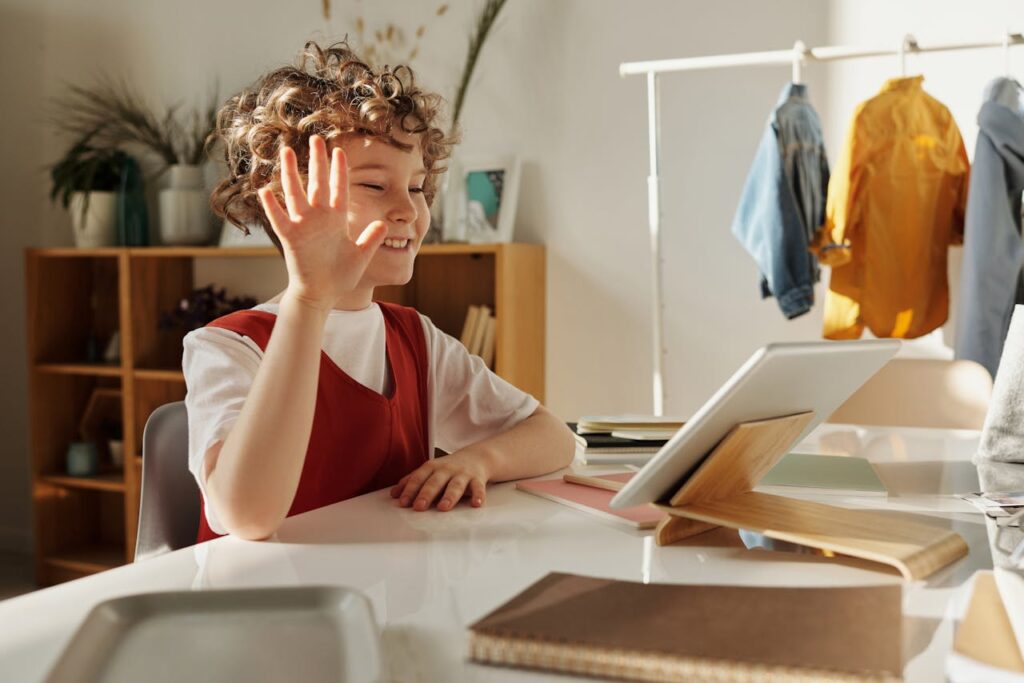“Children aged 8–12 average 4.43 ± 2.37 hours/day of recreational screen time and those with higher screen intake score significantly lower on mindfulness scales
 Problem: Beyond Screen Time—Tech Use Without Intention
Problem: Beyond Screen Time—Tech Use Without Intention
Children increasingly engage with digital devices without awareness or boundaries. This passive engagement hinders focus, emotional health, sleep, physical activity, and social skills. Mindful tech use—striking an intentional balance—can transform screen time into a tool for development rather than distraction.
 5 Research-Backed Insights
5 Research-Backed Insights
- Negative Link Between Screen Time and Mindfulness
Studies show that average children report 4.43 ± 2.37 hours/day of recreational screen time, and screen exposure correlates negatively with mindfulness - Mindfulness Improves Executive Function
School-based mindfulness increased behavioral regulation and executive functions by nearly one standard deviation in youth - Better Sleep with Mindful Training
A Stanford study found that mindfulness training for grades 3–5 increased nightly sleep by 74 minutes plus 24 minutes of additional REM sleep - Cognitive and Social Gains
The MindUP program in Canadian schools delivered a 15% math score increase, 24% less aggression, and 20% more prosocial behavior after 4 months - Online Mindfulness Reduces Hyperactivity
A 12-week virtual mindfulness program reduced hyperactivity in teens, even with high screen usage
 Defining the Opportunity
Defining the Opportunity
Mindful tech use is using devices with intention: understanding why, when, and how to engage. It’s about aligning online behaviors with values—learning, connection, creativity—rather than succumbing to distractions.

 5-Step “Mindful Tech for Kids” Framework
5-Step “Mindful Tech for Kids” Framework
- Mindset Check
Teach kids to ask: Why am I online now? Encourage clarifying purpose before screen-on. - Intentional Design
Collaborate on a tech-use plan. Decide device-free zones, dedicate creative and learning time, and block mindless scrolling. - Monitor & Reflect
Use built-in tools (Screen Time, Digital Wellbeing). Hold regular check-ins: how do you feel after this use? - Cultivate Mindfulness Habits
Integrate short meditation or breathing breaks before and after screen sessions. - Nature + Tech Balancing
Pair every digital session with time offline outdoors—nature resets focus and well-being.
 6-Week Mindful Tech Bootcamp
6-Week Mindful Tech Bootcamp
| Week | Goal | Actions |
|---|---|---|
| 1 | Awareness | Track screen use & feelings; explain mindful use goals. |
| 2 | Create Intent Practices | Begin mindset check (“pause-ask-intend”) before screens. |
| 3 | Design Tech Plan | Set device-free zones/times; establish outdoor reward sessions. |
| 4 | Integrate Mindfulness | Add 3–5 min breathing before/after tech use daily. |
| 5 | Group Reflection | Review progress weekly; share wins and obstacles. |
| 6 | Evaluation & Reset | Analyze data; adjust plan; set long-term “Mind Tech” practices. |
 Measurement Metrics: Track Growth
Measurement Metrics: Track Growth
- Mindfulness Score: Weekly child self-rating on awareness (1–10).
- Screen Time: Goal: <2 hrs/day recreational within 6 weeks.
- Sleep Duration: Track bedtime, wake time; aim for consistent nighttime hours.
- Mood Stability: Count mood dips after screen sessions.
- Attention Span: Use short timed tasks; assess focus in 1–5 min blocks.
- Outdoor Minutes: Aim for ≥60 minutes/day physical or nature play.
 Advanced Strategies for Optimization
Advanced Strategies for Optimization
- Tech Pause Protocol: 3-step pause before any digital use: Pause → Name Purpose → Proceed with Intention
- Digital Journal: Record app used, duration, emotions; weekly reflect for patterns.
- Mindful Media Playlists: Co-create playlists or games that encourage creativity, learning, or calm.
- Offline Rituals: Establish tech-off routines—pre-bed yoga, storytelling, gratitude journals.
- Family Mindful Sessions: Weekly shared mindfulness breaks pre or post-screen family session.
 Cross-Discipline Benefits
Cross-Discipline Benefits
- Sleep Optimization: Reduced blue light and mindful shutdown before bed enhance sleep quality
- Cognitive Enhancement: Improved focus, executive control support learning and memory.
- Stress Management: Mindful breaks lower cortisol and anxiety
- Emotional Regulation: Awareness practices reduce mood swings and impulsivity.
- Physical Health: Encouraging movement lowers sedentary lifestyle risk.
- Social Connection: Conscious tech use strengthens real-world engagement and empathy.
 Addressing Obstacles
Addressing Obstacles
- “They forget the pause.”
Use tech reminders or calendar alerts to reinforce intention setting. - “Peer pressure to be online.”
Encourage balanced accounts—showcase creative use; support content creation, not consumption. - “Resistance to offline time.”
Co-design offline alternatives aligned with their interests (sports, crafts, cooking). - “Tech overuse is habit-driven.”
Link mindful tech with pleasurable habits—nature walks, family games—to build motivation.
 Tailoring by Age
Tailoring by Age
- 5–8 years: Use visual timers, guided breathing, co-view apps with parents.
- 9–12 years: Introduce pause protocol, reflection journals, outdoor commitments.
- 13–17 years: Emphasize self-regulation, peer accountability, creative tech projects (coding, vlogging with purpose).
 Timeline and Results Expectations
Timeline and Results Expectations
- Within 2 weeks: Improved self-awareness and initially stabilized mood.
- By Week 6: Reduced screen-to-mindlessness ratio, better sleep, 1–2 hr/day less passive use.
- Over 3 months: Strengthened executive functioning, emotional control, more thirst for creative or learning screen use.
 Call to Action: Begin Today
Call to Action: Begin Today
- Start by asking your child: What’s your purpose today on screens?
- Try a 3-day mindful experiment: pause protocol + mindful breaks.
- Download a mindfulness app and schedule twice-daily 3-minute sessions.
- Track results: note changes in focus, mood, sleep.
- Check back in after 6 weeks to celebrate progress and set new mindful tech goals.
 Final Reflection
Final Reflection
Mindful tech use empowers children to thrive—leveraging digital tools for creativity, learning, and growth, rather than surviving their distractions. This intentional method builds a foundation of executive strength, emotional resilience, and holistic well-being.
Small, consistent mindful choices today shape lifelong habits tomorrow. If you’d like downloadable guides, family challenge kits, or classroom frameworks, I’d be happy to create them.





